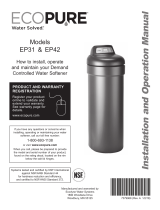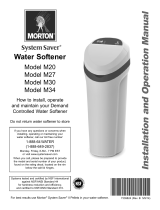16
FIG. 28
Cap
O-ring Seal
Screen Support
Screen
Gasket
*Flow Plug (HVDC)
Housing
Ferrule
Nut
Cone Screen
*Flow Plug
*Install with lettered
side up, concave
side down.
CLEANING THE NOZZLE & VENTURI
A clean nozzle & venturi (See Figure 28) is a necessity
for the water softener to work properly. This small
component creates the suction to move brine from the
brine tank, into the resin tank. If it should become
plugged with sand, silt, dirt, etc., the water softener will
not work, and hard water will result.
Nozzle & Venturi Disc
IMPORTANT: Be sure small hole in the gasket is
centered directly over the small hole in the nozzle &
venturi housing. Be sure the numbers are facing up.
Routine Maintenance
ADDING SALT
Lift the salt lid and check the salt storage level
frequently. If the water softener uses all the salt
before you refill it, you will experience hard water.
Until you have established a refilling routine, check the
salt every two or three weeks. Always add if less than
1/4 full. Be sure the brinewell cover is on.
NOTE: If using potassium chloride (KCl), do not fill
above level 4 on the brinewell decal.
NOTE: In humid areas, it is best to keep the salt
storage level lower, and to refill more often to
avoid salt “bridging”.
Recommended Salt: Nugget, pellet, or coarse solar
salts with less than 1% impurities.
Salt Not Recommended: Rock salt, high in impurities,
block, granulated, table, ice melting, ice cream making
salts, etc.
BREAKING A SALT BRIDGE
Sometimes, a hard crust or salt “bridge” forms in the
brine tank. It is usually caused by high humidity or the
wrong kind of salt. When the salt “bridges,” an empty
space forms between the water and the salt. Then,
salt will not dissolve in the water to make brine.
Without brine, the resin bed is not recharged and hard
water will result.
If the storage tank is full of salt, it is difficult to tell if
you have a salt bridge. A bridge may be underneath
loose salt. Take a broom handle, or like tool, and hold
it next to the water softener. Measure the distance
from the floor to the rim of the water softener. Then,
gently push the broom handle straight down into the
salt. If a hard object is felt before the pencil mark is
even with the top, it is most likely a salt bridge. Gently
push into the bridge in several places to break it. Do
not use any sharp or pointed objects as you may
puncture the brine tank. Do not try to break the salt
bridge by pounding on the outside of the salt tank.
You may damage the tank.
To get access to the nozzle & venturi, remove the
water softener’s top cover. Put the bypass valve(s)
into the bypass position. Be sure the water softener is
in the soft water (service) cycle (no water pressure at
nozzle & venturi). Then, holding the nozzle & venturi
housing with one hand, un screw the cap. Do not lose
the o-ring seal. Lift out the screen support and screen.
Then, remove the nozzle & venturi disc, gasket, and
flow plug(s). Wash the parts in warm, soapy water
and rinse in fresh water. Be sure to clean both the top
and bottom of the nozzle & venturi disc. If needed,
use a small brush to remove iron or dirt. Do not
scratch, misshape, etc., surfaces of the nozzle &
venturi.
Gently replace all parts in the correct order. Lubricate
the o-ring seal with silicone grease and locate in place.
Install and tighten the cap by hand, while supporting
the housing. Overtightening may break the cap or
housing. Put the bypass valve(s) into service (soft
water) position.
Recharge the softener to reduce the water level in the
tank. This will also assure that the softener is
completely recharged and ready to provide softened
water again. Check the water level in the tank by look-
ing down the brinewell. If the water level does not
drop after a recharge, the problem has not been
resolved. Call 1-866-986-3223.
Broom
Handle
Pencil
Mark
Salt
Salt
Bridge
Water
Level
Push Tool into
Salt Bridge to
Break
1" - 2"
FIG. 27

























